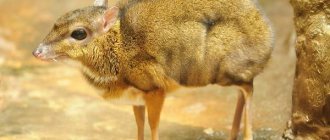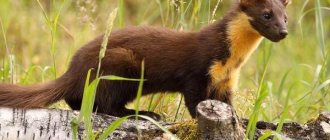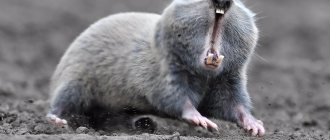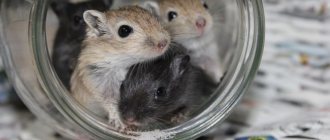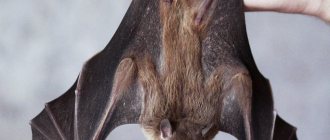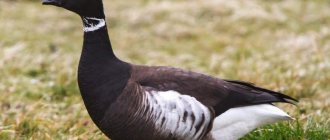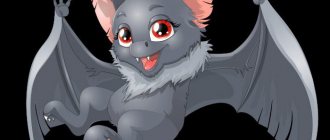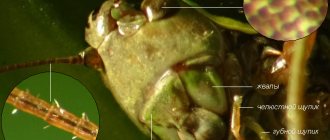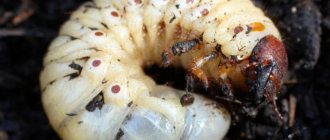Bats are amazing animals that look quite sinister and traditionally cause hostility in people. However, the fear of these cute animals that we experience thanks to horror movie scriptwriters is not justified.
According to scientists, bats have been on this planet much longer than us - they even managed to catch dinosaurs.
Although there are indeed species of bats that feed on blood, most bats are absolutely harmless to humans. Moreover, some people keep bats as pets because these creatures are very social and love the attention of their owners. When the owner of the animal leaves somewhere, the bat languishes without communication and may even die of melancholy.
Our selection includes the most beautiful bats in the world. Yes, some of them look strange and scary - and this is the aesthetics of the disgusting in its purest form.
California Leafnose / Macrotus californicus
As the name implies, this representative of a large order of leaf-nosed insects lives in the southwestern United States and Mexico.
Adults do not grow more than 6 cm, and weigh from 15 to 20 grams. But the wingspan is quite impressive, reaching 30 cm. They love dry, warm deserts, in which they masterfully hunt insects.
For hibernation, they choose abandoned mines or residential buildings, but most of all they settle in large colonies in caves.
2
Features of character and lifestyle
Photo: Simple bat
Bats are nocturnal. During the day they sleep, and at the same time they usually hide in various shelters, including underground. They are very fond of caves, tree hollows, earthen holes, as well as quarries and mines; they can hide under tree branches and under bird nests.
They usually live in small colonies of several dozen individuals. Although there are also more populous colonies, including those consisting of several different subspecies of bats. The colony of Brazilian folded lips, consisting of 20 million individuals, is considered to be the record in number today.
In winter, most bats hibernate. But some are capable of migrating like birds to warmer climes, covering distances of up to 1000 km. Hibernation, depending on the area, can reach 8 months.
Hibernation occurs upside down, by hanging on the hind legs. This turns out to be convenient so that you can immediately go on a flight, spending less effort and time. No energy is spent on hanging due to the structural features of the limbs.
Interesting fact: on the island of Borneo there is a unique carnivorous plant that attracts bats with special sounds. But it does not eat them, but on the contrary, provides its inflorescences to bats as a refuge. Animals leave their excrement for the plant, which it uses as fertilizer. In nature, such a symbiosis is unique.
For orientation in space and for hunting, they use echolocation, which helps them maneuver, control their flight altitude and distance to the walls of the cave. It is believed that during a hunt, bats become aware not only of the distance to the pursued target, but also the direction of its flight, and even what type of prey it belongs to.
White Leaf Beetle / Ectophylla alba
The inhabitant of Central and South America differs from its numerous relatives in its beautiful white body color, as well as its yellow nose and ears.
These beauties live in tropical rainforests, choosing caves high above sea level. They weigh only 7 grams and grow from 3.7 to 4.5 cm. Moreover, males are slightly larger than females.
The small bat prefers fruits in its diet, and the white leaf-nosed bat lives alone or in small groups of up to 6 individuals.
3
Varieties
White
The tailless or Honduran white bat is one of the small members of the family. In addition to Honduras, he also lives in Central America - Nicaragua, Costa Rica, Panama.
The body is up to 4.5 cm long , the ears are small, the nose is of an unusual shape. Through it, animals perform echolocation - this structure makes it possible to focus and amplify the signals sent.
They live under large heliconia leaves, gnawing holes in them so that the ends, hanging down, form a tent. They eat fruit .
Usually a family of 5-6 bats lives under one leaf, but sometimes several families unite into a large clan. Females give birth to one young per year .
Pig Nose
The hog-nosed bat, or bumblebee mouse, was discovered in 1973. The bat received its second name due to its size - the body is no more than 3.3 cm , and the weight is up to 2 grams. This is the smallest bat.
In addition, on the muzzle there is a characteristic nose, reminiscent of a pig's snout . The ears are large, but, unlike other animals of the family, the pig-nosed mouse does not have a tail.
The main habitat is Thailand and some neighboring lands. Lives in limestone caves and flies out to hunt in groups of 4-5 animals.
Do not move more than 1 km from the place of residence. Insects are looked for in thickets of bamboo or teak wood. There is no exact data on reproduction; most likely the female gives birth to one cub per year.
Vechernitsa
Evening bats are one of the large genera of bats, which includes 8 species and 13 subspecies. They live in Europe and North Africa, where they are the largest bats of their kind.
Body length - from 10 to 50 cm . It lives mainly in deciduous forests; it does not settle in treeless areas.
Hunts at dusk and dawn, preferring beetles and butterflies . The largest noctules are gigantic and can eat small songbirds .
REFERENCE! They are the fastest flyers - they can reach speeds of up to 60 km/h, rising to a height of up to 100 meters.
They are sensitive to frost, therefore, with the onset of cold weather, they migrate over distances of up to 1000 km. Females give birth to one or two, rarely three cubs.
Flying dog and fox
Flying dogs or flying foxes, the fruit bat is the common name for an entire species of animal, the fruit bat.
In essence, they are not insectivorous bats, but are closer in structure and development to herbivorous primates .
The main differences from each other are the food consumed , the structure of the wing, the use of echolocation in mice and vision in fruit bats.
These animals are not found in Russia ; their main place of residence is the Asian tropical forests of Vietnam, the Philippines, Malaysia, Laos and other countries.
They received the nickname “flying dogs” because of their characteristic elongated muzzle . Adult fruit bats are large in size - the body is up to 42 cm, the wings are up to 1.7 meters . Weight up to 900 grams.
They live in large colonies, settling in trees. They feed on tropical fruits , especially bananas, papaya, coconuts, grapes and others.
Due to their gastronomic preferences, fruit bats are called “fruit mice.” They do not eat the fruits, but only suck out the juice and pulp from them .
IMPORTANT! A flock of fruit bats can cause significant damage to a farm by “eating” the fruit on all the trees in the garden.
Animals sleep upside down . You can often observe a picture when on cold nights one wing is used as a blanket, wrapping the entire body, and on hot nights - instead of a fan.
The female gives birth to one cub per year.
Smooth-nosed
Smooth-nosed bats are a large family with more than 318 species.
They got their name due to the fact that they do not have any characteristic distinctive features; the muzzle is smooth without cartilaginous outgrowths .
The smooth-nosed family includes bats, bats, noctules, long-eared bats and many others.
They live all over the world where there is woody vegetation. There are 37 species of such mice found in Russia.
They are active at dusk or at night, when they hunt for various insects . Some species of bats eat fish .
During the cold period, hibernation occurs , but some (such as noctule bats) fly to warmer places (how and where do bats hibernate?). Females give birth once per season, 1-2, less often 3-4 individuals.
Ushan
Long-eared bats are a type of bat that have large ears used for echolocation. In sleeping animals they hide under folded wings.
Thanks to its short but wide wings, this animal can flutter and even hover briefly in the air to hunt insects. Body length - 5-6 cm .
Distributed throughout the continent from the Atlantic to the Pacific Ocean, in northern Asia, and North Africa.
They feed on mosquitoes, moths, beetles, and other similar insects . The female gives birth to one, less often two, cubs during the year.
Nocturnal
Noctules or short-eared bats are a species of smooth-nosed bat.
REFERENCE! The main difference from all similar animals is that they fly out to hunt very late, after complete darkness. At the same time, the flight itself is slow and calm.
Body length - 3.5-8.5 cm . Distributed throughout the world , except in the Arctic zones.
In general, they are the only species that has adapted to life in absolutely any natural conditions, even fatal to other bats. There are about 19 species in Russia.
They feed on nocturnal insects . The female brings one, or less often two, cubs during the year.
Horseshoe bats
Horseshoe bats are a species of bat that are so named because of the cartilaginous projection around their nose that looks like a horseshoe.
This structure is necessary for echolocation, the signals of which are emitted through the nostrils. Distributed in the eastern hemisphere , in Russia they live only in the Caucasus.
They eat insects , which they hunt in flight. They may freeze in place for a short time.
They fly out to hunt about half an hour after sunset, and are active during the first half of the night . Females give birth to only one cub during the year.
Bulldogs
Bulldog bats are a family that differs from all other tribesmen in having more developed wings - they are narrow, long and pointed.
Because of this, the flapping frequency is slightly higher than that of other mice. The average body length is 4-14.5 cm . They live in tropical regions of both hemispheres.
They can form groups of several tens to millions of individuals. The flight is rapid, the echoes are very high intensity.
Some species can produce 3 litters per year, consisting of one young each time.
Vampire
IMPORTANT! They are dangerous for people and domestic animals, since during a bite they can transmit rabies and various infectious diseases.
Vampire bats are a whole family whose members are parasites .
They feed only on the fresh blood of other animals or birds, and occasionally they can attack sleeping people .
Echolocation is poorly developed; when hunting, they rely more on excellent hearing and infrared receptors . With the help of the latter, the least protected area of the skin is determined.
They live in Central and South America (read more about where bats live and what their favorite places of settlement are here).
Indian flying fox / Pteropus giganteus
One of the largest species of flying mice has a head that resembles that of a dog, which is why the species is also called flying dogs.
The species is really large, because the wingspan reaches 130 cm, and the flying fox weighs from 900 to 1300 grams. And the range is limited to the Hindustan Peninsula.
They are nocturnal, so they see excellently in the dark, and echolocation is used only in extreme cases.
4
Horseshoe bats
These fliers got their name because of the horseshoe-shaped cartilaginous growth around their nose. This structure allows them to send echolocation signals through their nostrils. They live in the Eastern Hemisphere, “Russian” individuals inhabit only the territory of the Caucasus.
They begin hunting immediately after sunset and are most active in the first half of the night. Insectivores. The annual litter is only one cub.
Brown long-eared bat / Plecotus auritus
The second name is Ushan ordinary, and is named after its peculiar long ears, which have folds characteristic of the species in the lower part of the shells.
It is found on almost the entire continent of Eurasia, from Portugal to Kamchatka, in Central China and the Middle East. They spend the day in shelters, climbing into natural crevices, tree hollows or into the attics of houses.
Almost throughout its entire habitat, the species is classified as a rare, protected mammal.
5
Nocturnal
The short-eared mouse, also called the bat, is one of the subspecies of the smooth-nosed variety. It differs from other families of bats in its preference for complete darkness. Nocturnal bats fly out to hunt in the dead of night, when pitch darkness sets in.
This species of beautiful chiroptera is the most adapted of all to any living conditions, except for the Arctic cold. Therefore, it is distributed throughout the globe, except for the Arctic. Eats insects, gives birth to one, maximum two babies per year.
Large fruit-eating leaf-nosed insect / Artibeus lituratus
The small resident of Central and South America does not grow more than 101 mm in length, while the ears grow from 22 to 25 mm.
Their fur is short and smooth, usually dark brown in color, but their belly is light gray. They prefer to stay in groups of up to 20 individuals, and happily eat the fruits of various plants.
As zoologists say, this species is not in danger of extinction, but measures are still being taken to protect and maintain the proper population.
6
Social structure and reproduction
Photo: Flight of the Bat
Living together in a colony does not make bats gregarious. Animals do not perform any joint actions and also hunt exclusively alone. They also do not start families. Two individuals unite only at the moment of mating, and then immediately forget about each other.
Most bats that live in temperate climates begin breeding in the spring. Usually there are between two and five young in a litter, but the exact number varies greatly depending on environmental conditions. The female produces offspring once a year. She feeds the cubs until they develop wings. Maturation takes different times for different subspecies.
For small subspecies of bats, it typically takes 6 to 8 weeks until they become independent. For large subspecies of animals this period can reach four months. In the first week, the female usually takes the cub with her on night hunts. At the same time, he holds tightly to his mother during the flight. In the following weeks, he becomes heavy, so she leaves him in the shelter during the hunt.
Interesting fact: female bats have the ability to control their gestation time and also delay the birth of their offspring. They need this so that their offspring are born at a time when the amount of food is maximum. Very often, mating occurs in the fall, but fertilization occurs only in the spring.
The lifespan of bats directly depends on the specific subspecies. Mostly bats live 20 years, but there are subspecies with a life expectancy of no more than 5 years.
Red Hairtail / Lasiurus borealis
These amazing creatures live in North America, and by eating large quantities of insects, they help farmers preserve their crops.
This species is easily identified by the characteristic red color of its fur. They grow small and, like everyone else, are nocturnal. They spend daytime in dark secluded corners, hiding in caves or abandoned buildings.
Interestingly, females can give birth to twins and even quadruplets - double pairs of twins. In the first period, the female carries the cubs on her body, thereby giving them her warmth for life and development.
7
Spotted long-eared bat / Euderma maculatum
Very tiny bats with large ears in relation to the body live in North America, and in the USA they are protected by the state.
The body length of the spotted long-eared bat is 12 cm, and the tail grows up to 5 cm. Among other mice, they are distinguished by long pink ears and three white spots on their gray-brown back.
Females give birth to one cub, and, like many other species, the bat cub cannot fly for the first month and is under the care of the mother.
8
Nutrition
The structure of the teeth in each of the representatives of this suborder is different and directly depends on the feeding method of a particular species. Blood-sucking species have few teeth, only 20 pieces, but they are famous for their long fangs. Other bats have 38 of them.
However, their teeth are blunter and serve more likely to grind rough food that enters the mouth. Some blood-sucking species are able to cause significant harm to their victims, because the enzymes that enter the victim’s blood along with the saliva of attacking animals during a bite can provoke significant blood loss.
And if the attack is carried out by a whole group, for example, ordinary vampires, a fatal outcome is more than likely.
As already mentioned, night for such creatures is the time of hunting, and their active life begins with the last ray of the setting sun. These flying mammals do not see their victims, but hear them, catching their slightest movement.
Insectivorous species, in addition to winged little things and crawling insects, are capable of eating earthworms, small fish, and frogs. There are also enough species that eat exclusively fruits and drink flower nectar.
Lesser pipistrelle / Pipistrellus pygmaeus
In a large genus of pipistrelle bats, this is its smallest representative, not growing more than 45 mm. But its wings are from 18 to 21 cm.
Widely distributed throughout Europe, and settles near rivers and small streams. This is due to the fact that its diet is dominated by aquatic midges and land insects.
Buildings and, less often, tree hollows are chosen as resting places. They fly out to hunt at dusk, and spend time in shelters during the day.
9
White-bellied Arrowhead / Otonycteris hemprichii
A small mammal from the order Chiroptera was named after a German zoologist, and therefore in some reference books you can find the name Hemprich's arrow-eared bird.
The range of this wonderful creature is limited to Egypt and the Arabian Peninsula; it can also be found in the desert regions of Morocco. Their belly is light, but their back is covered with dark brown or sand-colored fur.
It lives in rock crevices, as well as in residential buildings, and is active at night, hunting insects.
10
Sense organs
Bats' response to light: The bat's retina lacks cones , the receptors responsible for daytime vision.
Their vision is twilight and is provided by rods. Therefore, during the day, animals are forced to sleep , since in daylight they see poorly.
Some representatives have eyes covered with bizarre folds of skin. This once again confirms the hypothesis that mice do not orient themselves in space using a visual analyzer . Close relatives of bats, fruit bats, also belonging to the order Chiroptera, have cones. These animals can also be seen during the day.
The secondary role of the visual analyzer for animals was revealed during a simple experiment : when the animals were blindfolded, they did not stop navigating their surroundings. When the same was repeated with the ears, the mice began to bump into walls and objects in the room.
Bats bring undoubted benefits to gardens and farms. In the dark, when birds are inactive, they massively destroy not only insect pests, but also small rodents. Read our articles about what these mysterious animals eat and what their habitat is.
Mediterranean Horseshoe Bat / Rhinolophus blasii Peters
Lives in Europe, North Africa, found in the mountainous regions of Transcaucasia, Asia Minor and Western Asia. In the USSR, and now in Russia, it is listed in the Red Book.
The body length is 46 - 54 mm, and the forearm reaches a length of 49 mm. They spend the day in mountain caves, choosing the most humid places, and at night they fly out to hunt, catching insects until dawn.
About the favorite habitats of bats, read on most-beauty.ru a fascinating article about mysterious and beautiful caves.
They prefer to stay in groups of 12-20 individuals, but they also feel great alone. The front part of the muzzle has an unusual outgrowth in the form of a horseshoe or saddle. Based on this characteristic, several types of horseshoe bats are distinguished.
11
Wool
The creature, based on the descriptions of different species, also differs in color. In 75% of cases, the mammal is gray, dark gray, or brown. This coloring helps to hide from predators and makes them invisible at night.
Mexican piscivorous species have yellow or orange fur. Some species are light yellow in color. Representatives of Honduras are albinos with yellow ears and nose.
The body and head are covered with fur. The wings are bare, with soft skin. This feature also applies to young nocturnal animals. The fur can be thick or sparse, with long or short pile. The habitat of the species plays a role here.
Interesting fact! There really is a vampire bat. But it feeds exclusively on the blood of small animals. It poses no danger to humans, even if she is very hungry. Maximum harm from flyers: babies fly poorly, so a collision may occur. Only the cub suffers from such blows.
Spectacled flying fox / Pteropus conspicillatus
In the lowland and humid tropical forests of Australia, as well as the islands of Oceania, you can meet the spectacled flying fox from the fruit bat family.
They grow up to 22 mm in length, and their wingspan is 1 m. They are distinguished not only by such huge wings, but also by characteristic circles around their eyes, making them look like monkeys.
These mice feed on fruits, drink nectar and eat flowers of tropical plants. Babies, after birth, live next to their mother for up to 5 months.
12
Lifestyle and habitat
In the culture and myths of many peoples, such animals usually appear as sinister negative characters. The ancients associated them not only with vampires, but also with other evil spirits: werewolves, sorcerers, witches.
These creatures personified darkness and death, but that is why the totem animal bat serves as a completely opposite symbol - rebirth: the rejection of everything that has become obsolete, the death of old habits and concepts, and therefore the entry into a new life.
If we list the areas of the planet where such representatives of the fauna settled, we should mention almost all of them, skipping only the edges of eternal snow and ice, as well as some islands surrounded by the ocean, since these flyers simply could not get there.
Zoologists believe that a bat can take root almost anywhere, in any climate and in a wide variety of conditions. The only thing she really needs is a quiet shelter where she can hide from the hated sunlight during the day.
Such creatures also do not tolerate noise and fuss, but even in large cities they can take a liking to some little-visited attic, even in a residential building. Therefore, they can rightfully be presented as pets . The bat has no fear of humans.
But some of the people are afraid of such guests, it’s just prejudice. However, this does not prevent exotic lovers from keeping these interesting creatures as pets.
In the wild, for example, in some spacious, mysterious cave, colonies of these animals can number in the tens of thousands of members, and even millions of individuals. In such a shelter they rest during the day, attaching their tenacious claws to the ledges, hanging upside down like ripe fruit.
But despite numerous aggregations and associations into communities, bats cannot be called social animals. Their social urges do not manifest themselves in any way. They communicate little with their relatives. They just sleep together during the day, that's all. And they hunt alone at night.
If bats live in regions with unfavorable climate, in winter they often go in search of nicer and warmer places. And such journeys sometimes take place thousands of kilometers away. But sometimes these creatures prefer to simply go into normal hibernation.
Bats can gather in columns of millions
Yellow-winged False Vampire / Lavia frons
This cute little animal is the only representative of the Lavia genus, and it lives in Central Africa.
With a body size of only 60-80 mm, the wingspan is 35 cm. They settle in dense forests near water bodies and spend the night on tree branches.
This species forms monogamous families and occupies a certain territory, which is protected by the male. The distance between the resting places of individual couples does not exceed 20 m.
13
Vechernitsa
One of the largest families of night shadows. It has 8 species with 13 subspecies. Inhabits the lands of North Africa and European countries. The largest bat of all bats. It can grow up to 50 cm. The animal settles in dense deciduous plantings and ignores open space.
Noctules fly out to hunt at dusk and in the predawn hours. They eat beetles and butterflies, but especially large individuals attack small birds. In addition to the largest sizes, they also have the fastest flight. Speed - 60 km/h at an altitude of 100 m. This species does not like frost, so it migrates to warm lands for the winter, covering about 1000 km. There may be two, rarely three cubs in a litter.
Malayan short-nosed fruit bat / Cynopterus brachyotis
The short-nosed fruit bat lives in southern and southeastern Asia and feeds on mangoes, although it can also eat other tropical fruits.
For the flora of this region of the planet, it plays an important role in plant pollination, since the mouse’s diet includes nectar and pollen. They weigh only 21-32 grams, and their life expectancy is 20-30 years.
At birth, the baby of this unique fruit bat can fit on the tip of a human finger.
14
Gambian epaulette fruit bat / Epomops franqueti
The African bat with such a sonorous species name feeds on figs and loves to eat mangoes and guava.
It grows up to 18 cm with a wingspan of up to 60 cm. They have soft brown fur on the body, but the abdomen is white. There are also white epaulets on the shoulders, and white spots on the ears.
They live in the central part of the African continent, and according to zoologists, the species is quite stable, which does not threaten the population decline.
15
California leaf-nosed bat
You can meet these amazing creatures in the warm deserts of Mexico and the USA. California leaf-nosed bats are harmless and do not drink blood - they prefer to feed on grasshoppers, butterflies and moths.
These babies weigh from twelve to twenty grams and have a body length of about six centimeters. The wingspan of the Californian leaf bat can reach thirty centimeters. They have funny long ears and a soft brown coat.
Gray Hairtail / Lasiurus cinereus
One hour after sunset, these mice begin to hunt moths and other insects, flying quickly between trees at a height of 10 meters.
The body length of the inhabitant of North and South America reaches 9 cm, and weight from 14 to 26 grams. The hairtail received its specific name because of the color of its short fur.
During the day they sleep high on the branches, hiding in the dense foliage of trees at a height of 3-5 m. By climbing so high, they escape from natural enemies that can attack them while sleeping.
16
Wings
Mammal flyers are creatures that have wings of a strange, but convenient shape for flight. They are membranes that are stretched between the limbs (back and front). The skin is thin, without feathers. The toes of the forelimbs are longer than the others. The membranes are attached to them.
The wingspan depends entirely on the type of animal. Reaches one to two meters. Quite strong and strong. Withstand heavy loads. They make the flight safe and your sleep sound, quiet, and warm. The wings additionally serve as a blanket, shelter from sunlight.
Madagascar fruit bat / Eidolon dupreanum
This cute inhabitant of Madagascar is found both on the coast and on the plateaus of the central part of the island.
The wingspan of this fruit bat reaches 78 cm, and the body length ranges from 14 to 22 cm. It feeds on fruits, but also happily eats the leaves of tropical trees.
Like many species, it is nocturnal and spends daylight hours in caves, gathering in colonies of 20 to 500 individuals. Interestingly, the similar climate of Africa did not attract this species, and it is found only in Madagascar.
17
Hog-nosed Bat / Craseonycteris thonglongyai
The rare and only pig-nosed species today was discovered relatively recently, only in 1973.
You can meet a small cute creature that does not grow more than 2.4 cm only in one of the provinces of Thailand. In the early 80s, only 160 individuals lived in three caves; today zoologists say that there are about 500 of them.
Note that this bat is the smallest, and also the smallest mammal living on our planet.
Distribution area
Bats live on literally every continent. Exception: isolated islands, highlands. Only one of the representatives - the northern leatherback - lives quietly and travels beyond the Arctic Circle. There are also islands on which this is the only creature of the order of mammals: Hawaii, Zealand, and the Azores.
Chiropterans feel great regardless of climatic conditions and ecosystems. They are divided into two suborders: Pteropodidae (fruit bats) and Microchiroptera. The second order is additionally numbered by 17 families.
